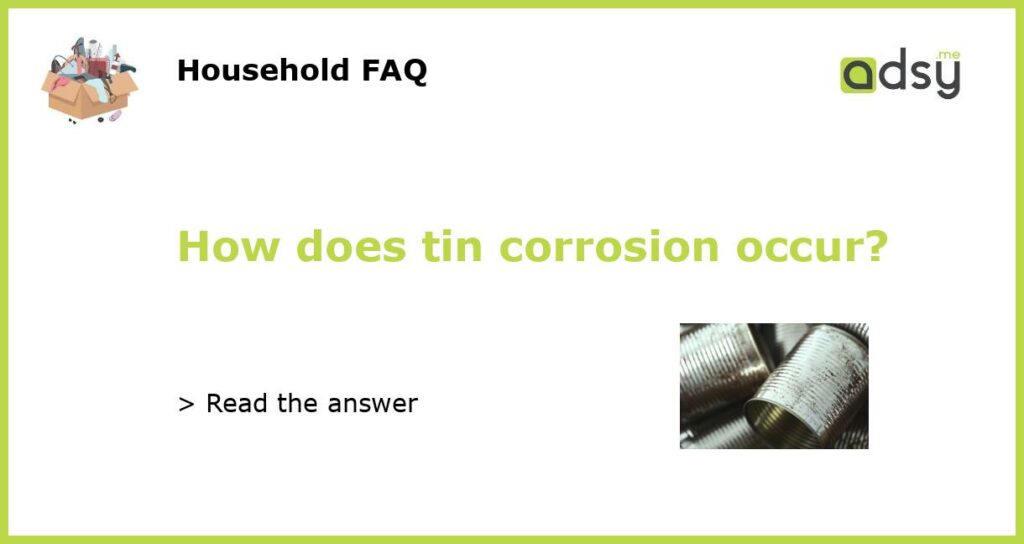What is tin corrosion?
Tin corrosion is the process of deterioration or degradation of tin, typically due to exposure to certain environmental conditions. This chemical reaction causes the metal to lose its original properties and can lead to the formation of a corrosive layer on the surface. Understanding how tin corrosion occurs is essential for preventing and mitigating the damage it can cause.
The factors that contribute to tin corrosion
Several factors contribute to the occurrence of tin corrosion:
- Moisture: The presence of moisture, especially in the form of water or high humidity, is one of the primary drivers of tin corrosion. When tin is exposed to water, it reacts with oxygen in the presence of moisture to form tin oxide, a corrosive layer that weakens the metal.
- Air pollutants: Certain air pollutants, such as sulfur dioxide and hydrogen sulfide, can accelerate the corrosion process by reacting with tin to form various tin compounds. These compounds can further degrade the metal and promote the formation of corrosion products.
- Acids: Acidic substances can corrode tin by reacting with the metal’s surface. Common examples include organic acids in food and beverages, as well as acid rain. The acidic nature of these substances accelerates the corrosion process.
- Salts: Salts, particularly chloride salts, can contribute to tin corrosion. When tin comes into contact with chloride ions, it forms tin chloride, which can corrode the metal surface. Salts are often found in seawater, coastal environments, and industrial atmospheres.
- Temperature: Extreme temperatures can have an impact on tin corrosion. High temperatures can accelerate the chemical reactions involved in corrosion, while low temperatures can lead to the formation of frost or ice, which can promote corrosion by trapping moisture.
The stages of tin corrosion
Tin corrosion typically occurs in several stages:
- Initial attack: The initial stage involves the reaction between tin and its surrounding environment. This starts with the formation of tin oxide on the metal’s surface, which acts as a protective layer against further corrosion. However, if the conditions are corrosive enough, this layer can be breached.
- Localized corrosion: If the protective layer is breached, localized corrosion can occur. This often manifests as pitting corrosion, where small pits or holes form on the surface of the tin. These pits can deepen over time and lead to further deterioration of the metal.
- General corrosion: In the absence of localized corrosion, general corrosion occurs. This involves a more uniform degradation of the metal across its entire surface. General corrosion may not be as visually noticeable as pitting corrosion but can still weaken the tin over time.
- Advanced stages: In the advanced stages of tin corrosion, the metal can suffer significant damage. It may become brittle and prone to fracturing, causing structural integrity issues. At this point, the corrosion process can be challenging to reverse, and the affected tin may require replacement.
Preventing and mitigating tin corrosion
Several measures can be taken to prevent or mitigate the occurrence of tin corrosion:
- Protective coatings: Applying a protective coating, such as a layer of paint or lacquer, can shield the tin from direct contact with corrosive substances in the environment. These coatings act as a barrier, preventing moisture, air pollutants, acids, and salts from coming into direct contact with the metal.
- Controlling humidity: Maintaining appropriate humidity levels can help reduce the risk of tin corrosion. This can be achieved through the use of humidity control systems, proper ventilation, and storing tin items in dry environments.
- Regular cleaning: Keeping tin surfaces clean and free from contaminants can help prevent corrosion. Regular cleaning removes any corrosive substances that may have accumulated on the metal and minimizes the risk of corrosion initiation.
- Storage and handling: Proper storage and handling practices can also contribute to the prevention of tin corrosion. Storing tin items in a cool, dry place away from corrosive substances and protecting them from physical damage can help prolong their lifespan.
- Galvanic protection: Galvanic protection involves using sacrificial anodes or applying a protective coating that is more prone to corrosion than tin itself. This way, any corrosive attack is directed towards the sacrificial material, preserving the integrity of the tin.
Tin corrosion prevention is key for preserving the metal’s properties
Tin corrosion can be detrimental to the integrity and functionality of tin-based products. Understanding the factors that contribute to corrosion and implementing preventive measures is crucial for maintaining the metal’s properties and prolonging its lifespan. By controlling moisture, protecting tin surfaces, and adopting proper storage practices, the risk of tin corrosion can be significantly reduced. Regular maintenance, cleaning, and monitoring are essential to detect any signs of corrosion early and take corrective actions promptly. Taking these steps will ensure that tin remains a durable and reliable material for various applications.






